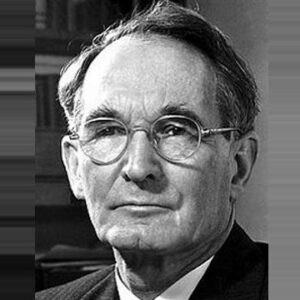Percy Williams Bridgman was an American scientist who was awarded the Nobel Prize in Physics for his work on the effects of pressure on solids, liquids, and gases. He invented self-tightening joints, which allowed scientists to conduct experiments in which pressures of up to 420,000 pounds per square centimeter could be applied using a special’seal’ he devised. Previously, scientists could only achieve a maximum pressure of 3,000 kilograms per square centimeter in their studies. He was the first to propose the “theory of operationalism,” which states that all scientific notions may be described using a set of operations. He had a fertile imagination, insight, and the ability to analyze mechanical details, which aided him in designing numerous types of scientific equipment. Throughout his career, he was never influenced by external factors such as societal demands, administrative work, or personal flaws in his experimental work. During WWI, he assisted in the development of sound detecting techniques for anti-submarine warfare. During WWII, he worked on the Manhattan Project, researching the compressibility of uranium and plutonium.
Childhood and Adolescence
Percy Williams Bridgman was born on April 21, 1882, in Cambridge, Massachusetts. He was the only child of Raymond Landon Bridgman, a newspaper reporter, and Mary ‘Maria’ Ann Williams, a public affairs author.
His father encouraged him to join the church because his family was quite devout, but he was more interested in science than religion.
After his family relocated to Newton from Cambridge, he attended the ‘Newton North High School’ in Newton, Massachusetts, where he graduated in 1900.
In 1900, he enrolled at Harvard University and graduated with a BA in physics and mathematics in 1904.
In 1905, he obtained his MA in physics from ‘Harvard University,’ and in 1908, he received his Ph.D. from the same institution.
From 1908 to 1910, he worked at Harvard University as a research fellow.
Percy Williams’s Career
In 1910, Percy Williams Bridgman began his career as a physics lecturer at Harvard University.
In 1913, he was promoted to associate professor, and in 1919, to full professor.
In 1926, Harvard University named him a “Hollis Professor of Mathematics and Natural Philosophy.”
He proposed the ‘theory of operationalism’ in 1927, in which he attempted to resolve the uncertainties and obscurities found in the definition of scientific ideas. The ‘Russell-Einstein Manifesto’ had 11 signatories, and he was one of them.
In 1942, he was elected President of the ‘American Physical Society.’
Bridgman was named a ‘Higgins Professor of Physics at Harvard University in 1950 and held the position until 1954.
In 1955, he worked as a consultant for the ‘General Electric Company,’ where scientists were experimenting with high-pressure procedures to transform graphite into synthetic diamonds.
Despite numerous attempts, he was unable to synthesize diamonds, while the extensions of his approach were eventually utilized to synthesize a variety of minerals.
He was a physics professor at Harvard University until 1954 when he retired.
Percy’s Major Projects
‘Dimensional Analysis,’ ‘The Logic of Modern Physics,’ ‘The Physics of High Pressure,’ ‘The Thermodynamics of Electrical Phenomenon in Metals,’ ‘The Nature of Physical Theory,’ ‘The Intelligent Individual and Society,’ and ‘The Nature of Thermodynamics,’ are among his works.
In 1950, he published his memoirs Reflections of a Physicist,’ and in 1964, he released the ‘Collected Experimental Papers’ in seven volumes.
Achievements and Awards
In 1917, the ‘Academy of Arts and Sciences’ awarded Percy Williams Bridgman the ‘Rumford Prize.’
In 1918, he was elected to the ‘National Academy of Sciences.’
In 1932, he was awarded the ‘Elliott Cresson Medal’ by the ‘Franklin Institute,’ the ‘Comstock Prize’ by the ‘National Academy of Sciences,’ the ‘Hendrik Willem Bakhuis Roozeboom Medal’ by the ‘Royal Academy of Sciences of the Netherlands,’ and the ‘Research Corporation Award’ by the ‘New York Award,’ in 1937.
In 1946, he received the Nobel Prize in Physics, and in 1951, he received the Bingham Medal from the Society of Rheology.
In 1934, he obtained an honorary D.Sc. degrees from the ‘Stevens Institute,’ the ‘Brooklyn Polytechnic,’ ‘Princeton University,’ the ‘University of Paris,’ and the ‘Yale University,’ among others.
The ‘American Association for the Advancement of Science,’ the ‘American Academy of Arts and Sciences,’ the ‘American Philosophical Society,’ and the ‘National Academy of Sciences’ all named him a fellow.
In London, he was named a ‘Foreign Fellow’ of the ‘Indian Academy of Sciences,’ a ‘Foreign Member’ of the ‘Royal Society,’ and an ‘Honorary Fellow’ of the ‘Physical Society.’ In addition, he joined the ‘Institute of Physics and the ‘Washington Academy of Sciences.’
Personal History and Legacy
He married Olive Ware in 1912, and the couple had two children: Jane Ware and Robert Ware.
On August 20, 1961, Percy Williams Bridgman shot himself in the head at his house in Randolph, New Hampshire.
For a long period, he battled metastatic cancer, which drove him to commit himself. ‘It isn’t decent for a society to have a man do this thing himself,’ he wrote in his suicide note. Probably this is the final day I will be able to do it myself.
In 1975, the US government classified the ‘Percy W. Bridgman House’ in Massachusetts as a ‘National Historic Landmark.’
In 1977, the ‘International Association for the Advancement of High-Pressure Science and Technology’ established the ‘Percy Williams Bridgman Award’ in his honor.
Bridgman, a lunar crater with an 80-kilometer diameter, has been named after him.
Bridgmanite is the name given to the earth’s most abundant mineral (Mg, Fe)SiO3 by the Commission on New Minerals, Nomenclature, and Classification (CNMNC) in 2014.
Percy Williams Bridgman was a perfectionist in every manner, a music lover, and chess, handball, mountain-climbing, photography, and gardening enthusiast.
He was generous and a man of integrity and was widely appreciated by his colleagues and other members of the scientific world.
Estimated Net worth
The scientist is Percy’s main source of income. We now lack sufficient information about his family, relationships, childhood, and other aspects of his life.Net Worth Estimated at 2019 $1 Million.


